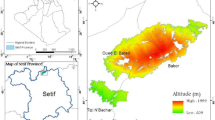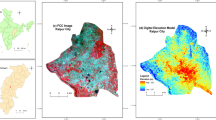Abstract
Chongce Ice Cap (35°14′N, 81°07′E), located in the south margin of Taklimakan Desert, West Kunlun Mts. of China was sampled by coring in 1992, and this provides us with climate proxy of high altitudes (6,530 m). Through analyzing the weather observation stations surrounding Taklimakan Desert, the climate record of Hotan station was chosen to be the representative of low altitudes. Wavelet analysis were used to investigate the climatic variations of patterns, cycles and frequencies of different altitudes from 1954 to 1992, and different responses of different altitude surrounding Taklimakan Desert to global warming were recorded: (1) coherent decline of snow accumulation rate and dust deposition of high altitude recorded in Chongce ice core; (2) coherent increase of summer half-year precipitation and SAT of Hotan; (3) consistent variation tendency between dust deposit recorded in Chongce ice core and Hotan spring sandstorm days; (4) opposite variation tendency between Hotan precipitation and Chongce ice core snow accumulation rate and consistent cycles in general. By analyzing the mechanism of different responses, the predominant factors were determined of different altitudes: (1) at the low altitude, the vapor supply is predominant, and more vapor supplying means more precipitation; (2) at the high altitude, probably the population of dust aerosols which act as cloud ice nuclei in high altitude takes advantage over the vapor supply to affect the precipitation, and so the dust aerosol population reducing results in the wet deposition being reduced, thus the dust aerosol is the predominant factor.












Similar content being viewed by others
References
Chen SB, Liu YF, Axel Thomas (2006) Climatic change on the Tibetan Plateau: potential evapotranspiration trends from 1961–2000. Clim Change 76:291–319. doi:10.1007/s10584-006-9080-z
Dansgaard W, Johnsen SJ, Clausen HB et al (1973) Stable isotope glaciology. Meddelelser Grφnland 197(2):1–53
Geng KH (1985) Features of eolian climate in the arid lands in China. In: Zhao SQ (ed) Physical geography of China’s Arid Lands. Science Press, Beijing, pp 36–49 (in Chinese)
Han J-K, Masayoshi Nakawo, Kumiko Goto-Azuma, Zhang WC (2005) Dating of a shallow ice core from Chongce ice cap using micro-particle content. J Glaciol Geocryol 27(6):846–452 (Chinese version with English abstract)
Han J-K, Masayoshi Nakawo, Kumiko Goto-Azuma, Lu C (2006) Impact of air burden fine dust on the mass balance of a high mountainous glacier: a case study of Chongce ice cap, west Kunlun Shan, China. Ann Glaciol 43:23–28
He Q, Yang Q, Li HJ (2003) Variations of air temperature, precipitation and sand-dust weather in Xinjiang in past 40 years. J Glaciol Geocryol 25(2):425–427 (Chinese version with English abstract)
Hu RJ, Jiang FQ, Wang YJ et al (2002) A study on signals and effects of climatic pattern change from warm-dry to warm-wet in Xinjiang. Arid Land Geogr 25(3):194–200 (Chinese version with English abstract)
IPCC (2001) Climate change 2001: impacts, adaptation, and vulnerability. The third report of working group II of the intergovernmental panel on climate change. Cambridge University Press, Cambridge, p 22
Jiao K-Q, Jing Z-F, Han T-D, Ye B-S, Yang H-A, Li Z-Q (2004) Variation of the Glacier No.1 at the headwaters of the Urumuqi river in the Tianshan Mountains during the past 42 years and its trend prediction. J Glaciol Geocryol 26(3):253–260 (Chinese version with English abstract)
Kang XC, Xie YQ (1989) The character of the weather and climate in West Kunlun mountains area in summer. Bull Glacier Res 6:83–88
Lau KM, Weng HY (1995) Climate signal detection using wavelet transform: how to make a time series sing. Bull Am Meteorol Soc 76(12):2391–2402
Li JiangFeng (1991) Climate of Xinjiang. Meteorological Press, Beijing, pp 180–186 (in Chinese)
Li ZQ, Han TD, Jin ZF (2003) A summary of 40-year observed variation facts of climate and Glacier No. 1 at headwater of Urumuqi River, Tianshan, China. J Glaciol Geocryol 25(2):117–123 (Chinese version with English abstract)
Liu HS, Chao BF (1998) Wavelet spectral analysis of the earth’s orbital variations and paleoclimatic cycles. J Atmos Sci 55(2):227–236
Liu SY, Ding YJ, Zhang Y et al (2006) Impact of the glacial change on water resources in the Tarim River basin. Acta Geogr Sin 61(5):482–490 (Chinese version with English abstract)
Lonnie H, Jiangping H (1996) Bivariate wavelet analysis of Asia monsoon and ENSO. Adv Atmos Sci 13(3):299–312
Ma MG, Dong LX, Wang XM (2003) Study on the dynamically monitoring and simulating the vegetation cover in northwest China in the past 21 years. J Glaciol Geocryol 25(2):252–256 (Chinese version with English abstract)
Merrill JT, Uematsu M, Bleck R (1989) Meteorological analysis of long range transport of mineral aerosols over the north Pacific. J Geophys Res 94(D6):6584–8598
Nakawo M, Ageta Y,Han JK (1990) Climatic information from the Chongce Ice Cap, West Kunlun, China. Ann Glaciol 14:205–207
Nakawo M, Goto-Azuma K, Han JK (1994) Decreasing trend of precipitation in the last 30 years at a mountain site near the Taklamakan Desert, western China. RIKEN Review No. 5 (April 1994): focused on earth and planetary environment, pp 11–12
Shi YF (2003) An assessment of the issues climatic shift from warm-dry to warm-wet in northwest China. Meteorological Press, Beijing, pp 18–22 (in Chinese)
Weng HY, Lau KM (1994) Wavelets period doubling, and time frequency western Pacific. J Atmos Sci 51:2523–2541
Xu CC, Chen Y, Li WH, Chen YP, Ge HT (2007) Potential impact of climate change on snow cover area in the Tarim River basin. Environ Geol. doi:10.1007/s00254-007-0755-1
Yang ZN (1991) Glacier water resources in China. Gansu Science and Technology Publishing House, Lanzhou, pp 140–141 (in Chinese)
Yu YX, Wang JS, Li QY (2003) Spatial and temporal distribution of water vapor and its variation trend in atmosphere over northwest China. J Glaciol Geocryol 25(2):149–156 (Chinese version with English abstract)
Zhang WC, Han JK, Nakawo M (1994) Ice coring operation and a preliminary observation of ice core taken at the Chongce Ice Cap, West Kunlun Mountains China. In: Proceedings of the Japan–China international symposium on the study of the mechanism of desertification. Research and Development Bureau Science and Technology Agency, Japan, pp 36–43
Zhang GW, Wu SF, Wang ZJ (2003) Reaction for signal of climatic shift from worm-dry to warm-humid in Northwest China in variation of river run-off in Xinjiang. J Glaciol Geocryol 25(2):183–187 (Chinese version with English abstract)
Zhang BL, Atsushi Tsunekawa, Mitsuru Tsubo (2007) Contributions of sandy lands and stony deserts to long-distance dust emission in China and Mongolia during 2000–2006. Glob Planet Change. doi:10.1016/j.gloplacha.2007.06.001
Zhao SQ (1985) The sandy deserts and the Gobi in China: their origin and evolution. In: Zhao SQ (ed) Physical geography of China’s Arid Lands. Science Press, Beijing, 1–17 (in Chinese)
Acknowledgments
We would like to thank Allan Grey, English teacher for Ph.D.’s at Lanzhou University, for his help revising the English in this paper. Special thanks owe to editors and anonymous reviewers whose constructive suggestions and detailed comments helped to clarify and improve the paper.
Author information
Authors and Affiliations
Corresponding author
Rights and permissions
About this article
Cite this article
Chongyi, E., Yong, W., Taibao, Y. et al. Different responses of different altitudes surrounding Taklimankan Desert to global climate change. Environ Geol 56, 1281–1293 (2009). https://doi.org/10.1007/s00254-008-1227-y
Received:
Accepted:
Published:
Issue Date:
DOI: https://doi.org/10.1007/s00254-008-1227-y




